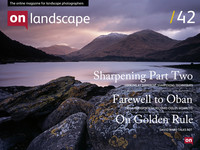Diffraction in photography

Tim Parkin
Amateur Photographer who plays with big cameras and film when in between digital photographs.
I was browsing through a few lens reviews in a couple of print magazines I receive and I noticed something a bit strange. Now most of us have the received wisdom that diffraction affects every lens and you can't do anything about it, f/22 must be avoided at all costs. Well, the results I was looking at showed a camera getting better resolution figures for f/22 than another camera at f/8 when both of the lenses were the manufacturer's stock 24-70 zooms and both cameras were the latest model!
Now some of your might have guessed which model had the better result, so give yourself a pat on the back if you figured out it was the D800. The other camera was the new Canon 5Dmk3. The question remains - how can this be? Well - I'm not completely willing to believe the result just because I haven't done the test myself but I do believe the general idea that this is so. It probably has something to do with a phenomenon a lot of film photographers had noticed when going to digital - stopping down on digital makes things a lot softer than stopping down on film.
This sounds odd but I think it has something to do with the fact that your resolving power at f/22 isn't just limited by diffraction. Well - it is - but there is more at play. For instance, if you had an absolutely hideously bad lens and shot it at f/22 and then shot a quality prime 50 at f/22, it's fairly obvious that the quality prime would show better resolving power. Well it's not just the lens that contributes, it's also the sensor. So in order to get the maximum resolution at f/22 you have to have a perfect lens and a perfect camera.
The D800 may not be perfect but it certainly has a resolution advantage over the Canon 5Dmk3. In terms of linear resolution the Nikon has a 27% advantage and the removal of the anti alias filter could have another 10-15% advantage (ballpark figure). Now this 40% total won't add to the resolution directly, but it will have an effect.
A lot of people may be looking online and finding resources like this that say at f/22 on a full frame sensor you should only have 4Mp of data! Shock horror!? Well Luminous Landscape have not always been right and it quite often the devil is in the details. Here's some details... (WARNING - GEEKY STUFF AHEAD SO YOU CAN SKIP FROM HERE >>>>)
Most resolution figures are quoted at a particular contrast level, usually 50% of the maximum contrast. However, our eyes can differentiate detail at between 2% and 5%. Luminous landscapes results, as far as I can tell, used am 80% MTF!!
The diffraction limit is usually quoted at 9% contrast and is 74 line pairs per mm for f/22 for green light.
However, for daylight (typically bluer) the value is 81.5 line pairs per mm.
And we can use some data from this page by Norman Koren to work out that the perceivable resolution for a line is better than for a spot (which the Rayleigh limit is based on) and so should be 102 lines per mm.
And finally, we can see contrast of between 2% and 5% depending on the observer. So lets say 5% and with a bit more reference to Mr Koren we find that we may be able to see 117 line pairs per mm.
( <<< TO HERE!! ) Now welcome back to all those people who skipped the last bit - the conclusion was that with a bit of maths and changing assumptions, the diffraction limit for f/22 of 74 line pairs per mm can become 117 line paire per mm. An increase of about 60% which results in a Megapixie increase about 150%!!
This is a huge difference from the 74 line pairs per mm usually quoted which for a sensor size of 36mm x 24mm this gives a resolution of 3456px by 5184px.
The 117 line pairs per mm gives 5616px by 8424px which is a stunning 46 megapixels!!! Now we have to include the bayer array in part of this discussion so the actual value would be less but it shows, theoretically, that you may still be able to see very low contrast detail at f/22 on a D800. This is the only thing that explains the results.
No obviously we'll be testing this and I don't expect the D800 to quite match these theoretical figures but it will be interesting to see just how close it gets. What you do see is that theoretical can get you any sort of figures you want and make them sound convincing. It's only the results that matter and hopefully the next issue will bring you some.

